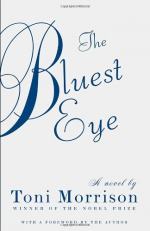|
This section contains 5,725 words (approx. 20 pages at 300 words per page) |

|
SOURCE: Scott, Lynn. “Beauty, Virtue and Disciplinary Power: A Foucauldian Reading of Toni Morrison's The Bluest Eye.” Midwestern Miscellany 24 (1996): 9-23.
In the following essay, Scott correlates Michel Foucault's theories about the workings of power in modern societies with Morrison's exploration of American racism in The Bluest Eye, demonstrating Morrison's contention that racism has less to do with exclusion than with the pressure to assimilate to cultural ideals of beauty and virtue.
In that young and growing Ohio town whose side streets, even, were paved with concrete, which sat on the edge of a calm blue lake, which boasted an affinity with Oberlin, the underground railroad station, just thirteen miles away, this melting pot on the lip of America facing the cold but receptive Canada—What could go wrong?
(The Bluest Eye, 93)
Set in a small, industrialized, Midwestern town on the eve of World War I, The Bluest Eye...
|
This section contains 5,725 words (approx. 20 pages at 300 words per page) |

|


